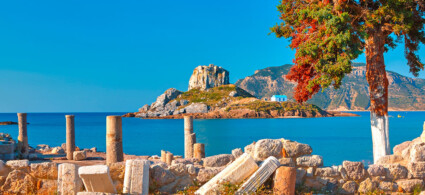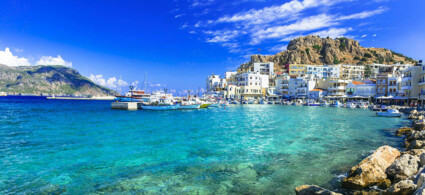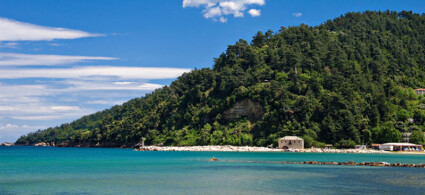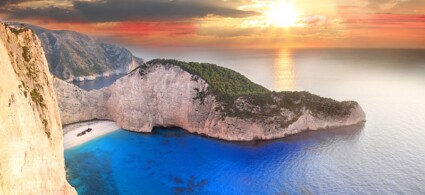

Where to look for relaxation, beautiful sea, ancient suggestions and warm hospitality if not in a Greek island? Each of the more than 200 inhabited Greek islands (if you also count the uninhabited ones, the Greek islands are more than 6000!) is potentially suitable for a dream vacation. But how to choose the one that best suits the type of vacation you want to have?
The Greek islands are grouped into seven main archipelagos, each marked differently by geography, history and the development of tourism.
While the Cyclades, the Greek islands most impressed in the collective imagination, are characterized by an arid and barren landscape, the Sporades are very rich in vegetation. The Ionian islands still show evident traces of the Venetian domination, while in the Dodecanese islands you can already breathe oriental atmospheres.
The Saronic are the weekend islands for many Athenians, and also the islands of the northern Aegean are very popular with Greek tourists and little known internationally. And then there is Crete, huge and wonderful.
Here is a guide to the archipelagos of the Greek islands that will help you find the ideal destination for your dream vacation.

The Cyclades are the most famous and most visited Greek islands: kissed by the sun, bathed by a very blue sea, they are enchanting places where postcard views follow one another at every step. The typical image of the Cyclades is that of a pretty village on the sea with a cascade of white houses with blue roofs.
The archipelago is located in the Aegean Sea, south of the Attica peninsula and Evia, and has more than 200 islands of which about twenty offer accommodation and services to tourists.
They are part of the Cyclades archipelago the two stars of Greek tourism, namely the chic Santorini and the transgressive Mykonos. They are probably the most expensive of all Greek islands but nevertheless continue to attract crowds of tourists: the first, of volcanic origin, bewitches tourists with its breathtaking views of the caldera and its romantic sunsets, the second makes them go wild with transgressive beach parties and clubs open until morning.
The other islands really satisfy all tastes, ranging from other well-known islands and full of services such as Naxos and Paros to lonely gems like Serifos, Anafi, Kea and Kithnos where time seems to stand still. Milos and Koufonissi are located a bit in the middle: still very quiet, they are rapidly growing in popularity.
Santorini and Mykonos are easy to reach thanks to numerous low cost flights. The other Cyclades islands must be reached by domestic flights departing from Athens or by ferry.



Located in the Ionian Sea to the west of mainland Greece and in part of Albania, the Ionian Islands are the Greek islands closest to the Italian coast and this proximity is not only geographical but also cultural: for several centuries they were dominated by the Venetians, who have left obvious traces in the architecture.
The most famous attraction of the entire archipelago is the Beach of the shipwreck, a beach of white sand set between imposing cliffs covered with vegetation where years ago a ship was wrecked, never removed. It is one of the images most used by websites and tourist guides about Greece and has become a symbol of the natural beauty of this country.
The beach of the wreck is located in Zakynthos, made famous by a poem by Ugo Foscolo, who was born on this island. Literary suggestions also in Ithaca, the mythical homeland of Ulysses, today an island suitable for those who love nature and tranquility, while Kefalonia, the largest island of the archipelago, is remembered by film lovers as the location of a famous Hollywood film.
In total there are seven Ionian Islands. The most famous is Corfu: equipped with many services compared to the smaller islands and with a rich historical heritage, it is an ideal destination for those who want to combine beautiful landscapes, cultural visits and comfort.

From the closest ones we move to the most distant ones: the Dodecanese islands are closer to the coasts of Turkey than to those of mainland Greece and therefore are the most distant ones. Also in this case geography and culture merge: for their history and their current appearance these islands metaphorically represent a bridge between West and East.
In spite of the name, the archipelago of Dodecanese includes much more than twelve islands: they are in fact about 160, of which 26 are inhabited.
The most famous and most visited is Rhodes, an island that includes everything you need for a dream vacation: beautiful beaches (both sandy and rocky), traditional villages, archaeological sites and cultural attractions, followed in the ranking of popularity there is Kos.
The other islands are all still little known to foreign tourists: a bit inconvenient to reach and with fewer services, they have the advantage of being quieter.




The Northern Sporades, commonly called the Sporades Islands, are a group of four islands in the northwestern sector of the Aegean Sea. Compared to the Cyclades, the Greek islands par excellence, they are much richer in vegetation and are much more populated, with some activities open throughout the year and not only in summer.
The most famous island of the archipelago is Skiathos: sophisticated and cosmopolitan, it is very loved by Greek tourists and not only. It boasts more than 60 beaches, paths in the green and a large number of clubs for those who love the nightlife.
The picturesque Skopelos, location of the musical Mamma Mia!, is still a traditional island with slow rhythms, perfect for a relaxing vacation between the sea and dinners in typical taverns. Alonissos is the farthest from the mainland and this discourages many tourists: those who have the tenacity to get here will find peace and the cleanest waters of the Aegean. Skyros is the least touristy, the place for those who want to immerse themselves in the local culture and make friends with the locals.



The Northern Aegean is not a real archipelago, but a label by which are defined a dozen islands and islets in the northeastern part of the Aegean Sea, closer to the west coast of Turkey than to mainland Greece.
The five main islands are Samos, Lesvos, Limnos, Ikaria and Chios. Of these, the first two are the most interesting for tourists: both boast a rich vegetation, a millenary history and famous citizens such as the poetess Sappho and the scientist Pythagoras and are therefore ideal for those who want to combine sea and cultural visits.


The Saronic islands are situated in the strip of sea between the north-eastern coasts of Peloponnese and the western coast of Attica. They are easily reachable from Athens and for this reason very loved by Greek tourists, while they still do not enjoy (unjustly) of international fame.
The island preferred by rich Athenians who want to escape from the city for a weekend of sea is Hydra, a chic island but definitely more accessible and less fashionable than Santorini. On the island is not allowed the circulation of cars and is connected to the mainland only by hydrofoils.
The other islands of the archipelago are Salamina, Aegina, Agistri, Poros, Spetses and Dokos.

Not part of any of the archipelagos previously mentioned is the island of Crete, which far exceeds all other Greek islands in size and is one of the largest in the entire Mediterranean. It is located in the Aegean Sea, about a hundred kilometers south of mainland Greece.
Crete is a small world unto itself, large enough and rich enough in attractions to fill more than a vacation on its own: a varied landscape, an impressive number of enchanting beaches, archaeological sites and cultural attractions among the most important in Greece (including the impressive palace of Knossos, where according to legend the fearsome Minotaur was imprisoned).

